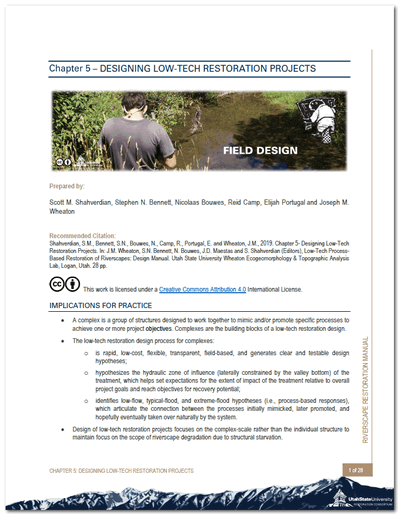Chapter 5: Designing Low-Tech Restoration Projects
The fifth chapter covers the low-tech process-based restoration design process. This process is generic to designing any type of low-tech process-based restoration treatment (not just PALS & BDAs). Specifically, it covers:
- Key Principles for Designing Low-Tech Restoration Projects
- Getting Started – Design and Required Information
- A Low-Tech Design Plan
- Design of a Complex
- Considerations for Common Complex Objectives
- The Importance of Time and Flow Conditions
Chapter 5 also has an appendix on:
- Appendix A: The Topographic Paradox
Full PDF available for free at ResearchGate, but requires a free account.
Implications for Practice
Key Takeaways:
- A complex is a group of structures designed to work together to mimic and promote specific processes to meet project objectives. Complexes are the building blocks of a low-tech restoration design.
- The low-tech restoration design process for complexes:
- is rapid, low-cost, flexible, transparent, field-based, and generates clear and testable design hypotheses;
- hypothesizes the hydraulic zone of influence (laterally constrained by the valley bottom), helping set expectations for treatment impact relative to project goals and reach objectives for recovery potential;
- identifies low-flow, typical-flood, and extreme-flood hypotheses (process-based responses) to articulate the connection between processes initially mimicked, later promoted, and eventually sustained naturally by the system.
- Design of low-tech restoration projects focuses on the complex-scale rather than individual structures to better address riverscape structural starvation.
- Complexes typically include between 2–15 structures, and their objectives may differ or align depending on project goals and reach recovery.
- Learning, innovation, and refinement of design improve when clear, testable hypotheses are defined at the complex-scale.
Recommended Citation
Shahverdian, S.M., Bennett, S.N., Bouwes, N., Camp, R., Portugal, E., and Wheaton, J.M. 2019.
Chapter 5 – Designing Low-Tech Restoration Projects.
In: J.M. Wheaton, S.N. Bennett, N. Bouwes, J.D. Maestas, and S.M. Shahverdian (Editors), Low-Tech Process-Based Restoration of Riverscapes: Design Manual.
Utah State University Wheaton Restoration Consortium, Logan, Utah. 28 pp.
DOI: 10.13140/RG.2.2.11621.45286
Minimum Viable Design Package

